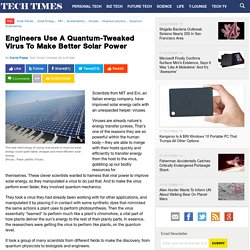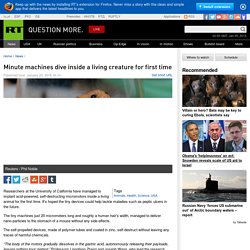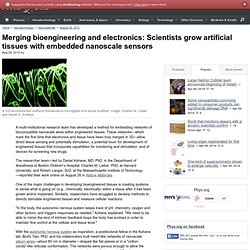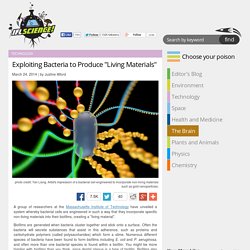

This Bandage Glows Green When You're Infected. Science AMA Series: We 3D-print self-assembling blood vessels and create human biological systems on a chip. Ask Us Anything! : science. Engineers Use A Quantum-Tweaked Virus To Make Better Solar Power. The new technology of using viral power to improve solar energy could spell faster, cheaper and more efficient solar energy.

(Photo : Peter Jelliffe | Flickr) Scientists from MIT and Eni, an Italian energy company, have improved solar energy cells with an unexpected helper: viruses. Viruses are already nature's energy transfer junkies. That's one of the reasons they are so powerful within the human body—they are able to merge with their hosts quickly and efficiently to transfer energy from the host to the virus, gobbling up our bodily resources for themselves. These clever scientists wanted to harness that viral power to improve solar energy, so they manipulated a virus to do just that. They took a virus they had already been working with for other applications, and manipulated it by placing it in contact with some synthetic dyes that mimicked the same actions a plant uses to perform photosynthesis. Scientists Grew a Rat Limb in the Lab Researchers grow cyborg tissue that can sense its environment. Artificial Photosynthesis Yields Valuable Chemicals.
Tiny semiconductors and bacteria have been combined to create a system that uses sunlight to turn carbon dioxide into valuable chemicals.

Photosynthesis forms the basis of most life on Earth. However, it cannot draw carbon dioxide out of the atmosphere fast enough to match the rate at which we are releasing what was stored over millions of years. This has led to a quest to produce an artificial and more efficient version – ideally one that would turn the carbon into something we can easily use. Recently, there has been a lot of work based around the idea of combining bacteria with manufactured materials. The Lawrence Berkeley National Laboratory has announced what team leader Professor Peidong Yang calls “a revolutionary leap forward” in this area.
"Our system has the potential to fundamentally change the chemical and oil industry in that we can produce chemicals and fuels in a totally renewable way, rather than extracting them from deep below the ground,” says Yang. Credit: Berkeley Lab. Minute machines dive inside a living creature for first time — RT News. Published time: January 23, 2015 16:10 Reuters / Phil Noble Researchers at the University of California have managed to implant acid-powered, self-destructing micromotors inside a living animal for the first time.

It's hoped the tiny devices could help tackle maladies such as peptic ulcers in the future. The tiny machines just 20 micrometers long and roughly a human hair's width, managed to deliver nano-particles to the stomach of a mouse without any side effects. The self-propelled devices, made of polymer tubes and coated in zinc, self-destruct without leaving any traces of harmful chemicals. “The body of the motors gradually dissolves in the gastric acid, autonomously releasing their payloads, leaving nothing toxic behind,” Professors Liangfang Zhang and Joseph Wang, who lead the research, wrote in the journal ACS Nano. While the machines dissolve, they deliver their vital contents into the stomach tissue. Bionic Plants: Turning Plants Into Energy Producing Factories. New chemical circuits make becoming a cyborg even cooler.
Merging bioengineering and electronics: Scientists grow artificial tissues with embedded nanoscale sensors. A multi-institutional research team has developed a method for embedding networks of biocompatible nanoscale wires within engineered tissues.

These networks—which mark the first time that electronics and tissue have been truly merged in 3D—allow direct tissue sensing and potentially stimulation, a potential boon for development of engineered tissues that incorporate capabilities for monitoring and stimulation, and of devices for screening new drugs. The researcher team—led by Daniel Kohane, MD, PhD, in the Department of Anesthesia at Boston Children's Hospital; Charles M. Lieber, PhD, at Harvard University; and Robert Langer, ScD, at the Massachusetts Institute of Technology—reported their work online on August 26 in Nature Materials. One of the major challenges in developing bioengineered tissues is creating systems to sense what is going on (e.g., chemically, electrically) within a tissue after it has been grown and/or implanted.
3D Printing Droplet Networks. Peter Rothman Oxford University scientists have demonstrated a custom-built programmable 3D printer which can create materials with several of the properties of living tissues.

The new type of material consists of thousands of connected water droplets, encapsulated within lipid films, which can perform some of the functions of the cells inside our bodies. These printed 'droplet networks' could be the building blocks of a new kind of technology for delivering drugs and potentially one day replacing or interfacing with damaged human tissues. Because these droplet networks are entirely synthetic, have no genome and do not replicate, they avoid some of the problems associated with other approaches to creating artificial tissues – such as those that use stem cells.
The team report their findings in this week's Science: Each droplet is an aqueous compartment about 50 microns in diameter. Exploiting Bacteria to Produce "Living Materials" A group of researchers at the Massachusetts Institute of Technology have unveiled a system whereby bacterial cells are engineered in such a way that they incorporate specific non-living materials into their biofilms, creating a "living material".

Biofilms are generated when bacteria cluster together and stick onto a surface. Often the bacteria will secrete substances that assist in this adherence, such as proteins and carbohydrate polymers (called polysaccharides) which form a slime. Numerous different species of bacteria have been found to form biofilms including E. coli and P. aeruginosa, and often more than one bacterial species is found within a biofilm. You might be more familiar with biofilms than you think, since dental plaque is a type of biofilm.
Biofilms also often frequent pipes and can cause clogging and erosion. Gizmodo. New Injectable Brain Implants Take Us One Step Closer To A Cyborg Future. Biodegradable 3D Printed Artificial Bone that Adapts to the Human Body. Animal studies and trials are some of the few requirements in the pharmaceutical and surgical industries that need to be provided if a new drug or a medical technology is to be introduced to the public.

This week, scientists at Xi’an Particle Cloud Advanced Materials Technology Co., Ltd. have successfully carried out a round of animal testing on their medical procedure that allows the fabrication of completely biodegradable intricate artificial bone structures. The trials conducted by the team of scientists at the Department of Orthopedic Surgery at Xijin Hospital in Xi’an, China focused to ensure the safety of inserting a 3d printed body part inside a human body. During the trials, the scientists created a defect in the bottom part of the femur or the thigh bone of a rabbit. Then, a 3d printed artificial bone was developed and was implanted on the defected bone.